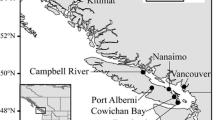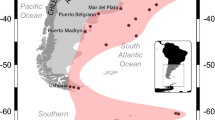Abstract
Observational and experimental studies were conducted on the dispersal of fouling organisms on a replica of a 16th-century sailing vessel along an 800 km transect from Yaquina Bay, Oregon to San Francisco Bay, California. The vessel sailed between four bays at slow speeds (3.5 to 4 knots), resided in each bay for approximately 30 d, and spent 1 to 3 d in the open ocean travelling between ports. Natural hull fouling and experimental fouling panels placed on the vessel were sampled upon departure and arrival at each port. All common fouling species survived the open sea voyages between the harbors, with largely no ecologically significant changes in abundance nor significant losses in overall diversity detected. In one port the vessel settled upon the harbor floor periodically; several entrained benthic organisms were then transported 390 km to the next port. Slow-moving, fouled sailing vessels of relatively long port residencies may have significantly altered the distributions of marine and estuarine organisms not only globally (leading to the invasions of non-native species) but also along continental margins (leading to the alteration of aboriginal patterns of distribution). Shipping traffic may further play an important role in gene flow between isolated populations of obligate estuarine organisms, particularly those with non-planktonic larvae.
Similar content being viewed by others
References
Allen FE (1953) Distribution of marine invertebrates by ships. Aust J mar Freshwat Res 4:307–316
Bertelsen E, Ussing H (1936) Marine tropical animals carried to the Copenhagen Sydhavn on a ship from the Bermudas. Vidensk Meddr dansk naturh Foren 100:237–245
Carlton JT (1979a) History, biogeography, and ecology of the introduced marine and estuarine invertebrates of the Pacific coast of North America. Ph.D. dissertation, University of California, Davis
Carlton JT (1979b) Introduced invertebrates of San Francisco Bay. In: Conomos TJ (ed) San Francisco Bay: the urbanized estuary. American Association for the Advancement of Science and the California Academy of Sciences, San Francisco, pp 427–444
Carlton JT (1985) Transoceanic and interoceanic dispersal of coastal marine organisms: the biology of ballast water. Oceanogr mar Biol Rev 23:313–371
Carlton JT (1987) Patterns of transoceanic marine biological invasions in the pacific Ocean. Bull mar Sci 41:452–465
Carlton JT (1989) Man's role in changing the face of the ocean: biological invasions and implications for conservation of near-shore environments. Conserv Biol 3:265–273
Carlton JT (1992) Blue immigrants: the marine biology of maritime history. The Log Mystic Seaport 44:31–36
Carlton JT, Geller JB (1993) Ecological roulette: the global transport of nonindigenous marine organisms. Science, NY 261:78–82
Carlton JT, Scanlon JA (1985) Progression and dispersal of an introduced alga Codium fragile tomentosoides (Chlorophyta) on the Atlantic coast of North America. Bot mar 28:155–165
Carlton JT, Thompson JK, Schemel LE, Nichols FH (1990) Remarkable invasion of San Francisco Bay (California, USA) by the Asian clam Potamocorbula amurensis. I. Introduction and dispersal. Mar Ecol Prog Ser 66:81–94
Carriker MR (1967) Ecology of estuarine benthic invertebrates: a perspective. In: GH Lauff (ed) Estuaries, American Association for the Advancement of Science, Washington, DC
Chapman J, Carlton JT (1991) A test of criteria for introduced species: the global invasion by the isopod Synidotea laevidorsalis (Miers 1881). J Crust ocean Biol 11:386–400
Chilton C (1911) Note on the dispersal of marine Crustacea by means of ships. Trans N Z Inst 43:131–133
Clapp WF, Kenk R (1963) Marine borers. An annotated bibliography. Office of Naval Research, Department of the Navy, Washington DC
Conlan KE (1990) Revision of the crustacean amphipod genus Jassa Leach (Corophioidea: Ischyroceridae). Can J Zool 68(10):2031–2075
Cronin TW (1982) Estuarine retention of larvae of the crab Rhithropanopeus harrisii. Estuar cstl Shelf Sci 15:207–220
Cumming AA (1985) Sir Francis Drake and The Golden Hinde. Jarrold & Sons, Ltd., Norwich, England
de Wolf P (1974) On the retention of marine larvae in estuaries. Thalassia jugols 10:415–424
Drake JA, Mooney HA, di Castri F, Groves RH, Kruger FJ, Rejmanek M, Williamson M (eds) (1989) Ecology of biological invasions: a global perspective. SCOPE 37. John Wiley and Sons, New York
Furman ER, Yule AB (1991) Balanus improvisus in British estuaries: gene-flow and recolonization. In: Elliott M, Ducrotoy J-P (eds) Estuaries and coasts: spatial and temporal intercomparisons. Olsen and Olsen, International Symposium Series. University of Caen, France, pp 122–129
Furman ER, Yule AB, Crisp DJ (1989) Gene flow between populations of Balanus improvisus Darwin (Cirripedia) in British estuaries. Scient Mar 53:465–472
Golden Hinde Ltd (1986) The Golden Hinde. London
Hall A (1981) Copper accumulation in copper-tolerant and non-tolerant populations of the marine fouling alga, Ectocapus siliculosus (Dillw.) Lyngbye. Bot mar 24:223–228
Hawkins R (1622) The observations of Sir Richard Hawkins, knight, in his voiage into the South Sea, Anno Domini, 1593. London (cited in Clapp and Kenk 1964:443)
Kornberg H, Williamson MH (eds) (1986) Quantitative aspects of the ecology of biological invasions. Phil Trans R Soc Lond (Ser B) 314:501–746
Kozloff EN (1987) Marine invertebrates of the Pacific northwest. University of Washington Press, Seattle
Lindroth CH (1957) The faunal connection between Europe and North America. John Wiley and Sons, New York
Linschoten JH van (1596) Voyage of Jan Huygen van Lischoten to the East or the Portuguese Indies. Amsterdam (cited in Clapp and Klenk 1963:608)
Lloyd C (1975) Atlas of maritime history. Arco Publishing Co., Inc., New York
Moll F (1928) Die Bohrmuschel (Teredo navalis) in der älteren Literatur. Arch Gesch Math Naturw Tech 11:123–149
Moll F (1935) Le Teredini del Mediterraneo dal punto di visa tecnico. Boll Pesca Piscic Idrobiol 11:838–843
Mooney HA, Drake JA (eds) (1986) Ecology of biological invasions of North America and Hawaii. Ecological Studies 58. Springer-Verlag, New York
National Oceanic and Atmospheric Administration (NOAA) (1987) Oceanographic Analyses [issued biweekly]. National Weather Service Forecasting Office, Redwood City, CA
Natkiel R, Preston A (1986) Atlas of maritime history. Facts on File, Inc., New York.
Pyefinch KA (1950) Notes on the ecology of ship-fouling organisms. J Anim Ecol 19:29–35
Roginskaya IS (1970) Tenellia adspersa, a nudibranch new to the Azov Sea, with notes on its taxonomy and ecology. Malac Rev 3:167–174
Roos PJ (1979) Two stage life cycle of a Cordylophora population in the Netherlands. Hydrobiologia 62:231–239
Rungger D (1969) Autotomy in Tubularia crocea and its ecological and physiological significance. Pubbl Staz zool napoli (I: Mar ecol) 37:95–139
Russell G, Morris OP (1973) Ship-fouling as an evolutionary process. In: Acker RF, Brown BF, De Palma JR, Iverson WP (eds) Proceedings of the Third International Congress on Marine Corrosion and Fouling. Northwestern University Press, Evanston, Illinois, pp 719–730
Skerman TM (1960) Ship-fouling in New Zealand waters: a survey of marine fouling organisms from vessels of the coastal and overseas trades. N Z Jl Sci 3:620–648
Smith RI, Carlton JT (1975) Light's manual: intertidal invertebrates of the central California coast. University of California Press, Berkeley, CA
Turner R (1966) A survey and illustrated catalogue of the Teredinidae (Mollusca: Bivalvia). Museum of Comparative Zoology, Harvard University, Cambridge MA
Wilkinson JJ (1841) On lead sheathing for ships. Minutes of Proceedings, Institute of Civil Engineers, 1, Session 1841:132–135 (cited in Clapp and Kenk 1963:1044)
Zevina GB, Kuznetsova IA (1965) The part played by navigation in modifying the Caspian fauna. Oceanology 5:101–108
Author information
Authors and Affiliations
Additional information
Communicated by J.P. Grassle, New Brunswick
Rights and permissions
About this article
Cite this article
Carlton, J.T., Hodder, J. Biogeography and dispersal of coastal marine organisms: experimental studies on a replica of a 16th-century sailing vessel. Marine Biology 121, 721–730 (1995). https://doi.org/10.1007/BF00349308
Received:
Accepted:
Issue Date:
DOI: https://doi.org/10.1007/BF00349308




